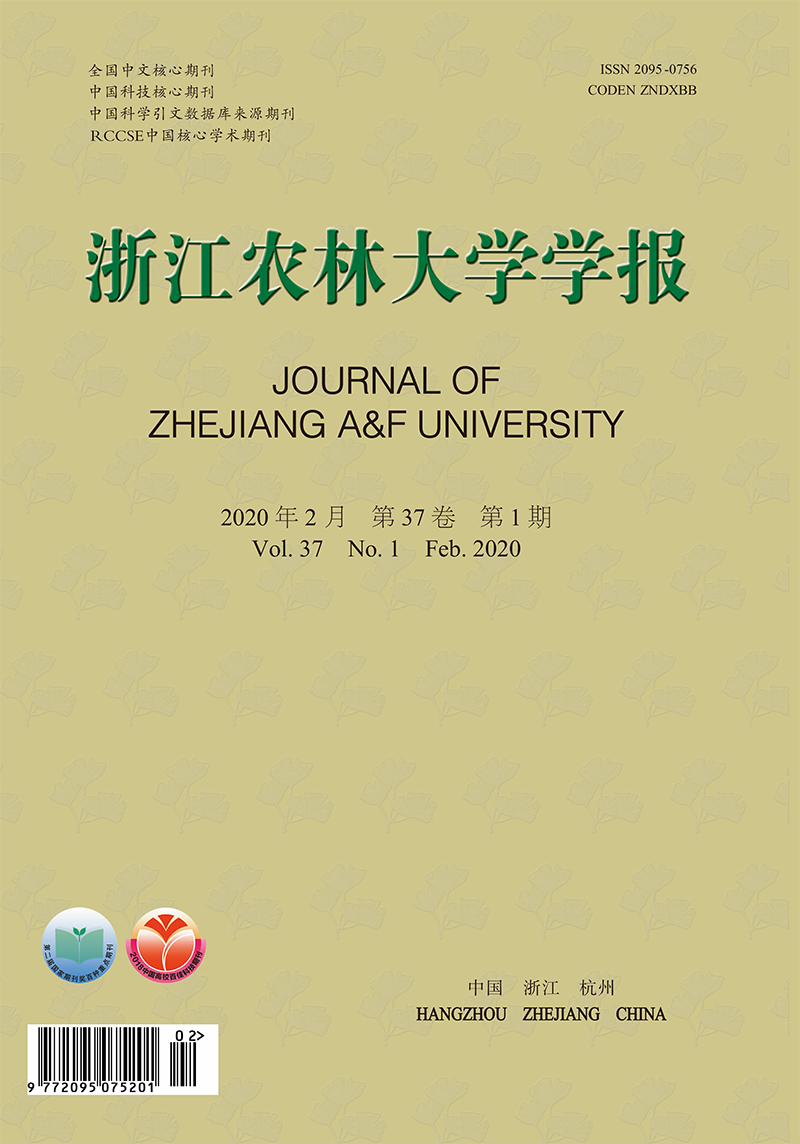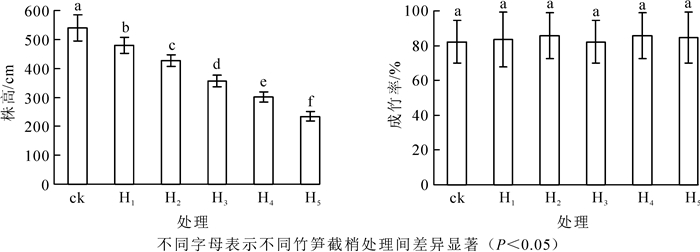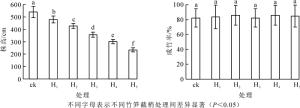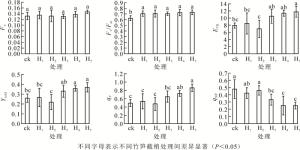-
矮化是一种重要的农艺性状, 在改善空间和土地利用率, 调整栽培密度, 提高抗倒伏能力等方面具有明显的形态特征优势[1]。竹类矮化措施在生产实践中主要应用于3个方面:①中国南方及长江流域冰冻雪灾给竹类生产带来严重的经济损失, 破坏了生态环境[2-4]。钩梢矮化是抵御冰雪风折灾害的有效措施。②笋用竹设施栽培受到常规温室高度的限制[5-6], 每年秋冬季降温前盖膜需要钩梢, 矮化植株方便日常经营管理。③园林景观中矮化竹植株构型具有较高观赏价值[7]。目前, 关于竹类矮化方法及矮化后笋产量[8-9]、光合生理[10]以及材性力学性质[11]等方面已有诸多研究。生产中常用的竹类矮化方法有钩梢[3-4]或利用植物生长调节剂[3, 5, 7, 12]抑制竹居间分生组织生长达到矮化目标。但钩梢会直接带走大量秆枝叶, 造成营养生长损耗。同时成竹株高较高、竹秆硬度强增加了钩梢难度。使用植物生长调节剂造成药剂残留且连续多次施药效果受到天气影响, 矮化成本较高。此外, 通过断鞭[13]、剥除笋箨[14]、修剪[15]限制营养供给来控制高度生长的竹类矮化方法也有研究报道, 但在生产实践中并不常见。绿竹Dendrocalamopsis oldhami是中国南方地区优良的笋材两用丛生竹种, 其材性优良、竹笋产量高, 具有较好的经济和生态价值[16]。但绿竹鲜笋不耐储存, 限制了绿竹笋的销售范围。绿竹笋在北方蔬菜市场尚属空白, 发展笋用绿竹具有较好的经济前景。随着"南竹北移"的实施, 受日光温室高度限制, 秋冬季需要钩梢。因此, 探索一种易操作、无药剂残留且不影响竹子正常生长的矮化方法尤为必要。光合作用是植物生长发育物质能源积累的基础[17]。光合能力与植物不同植株构型有着密切关系。习玉森等[18]指出矮化型桃Amygdalus persica在强光、高温胁迫下较正常植株光抑制程度轻, 物质积累能力强。罗静等[19]指出矮化苹果Malus pumila苗叶绿素含量增加具有较高的净光合速率而早产。本研究在借鉴成竹秋冬季钩梢实践基础上, 将矮化时间提前至笋期, 提出竹笋截梢的矮化方法, 比较不同高度竹笋截梢对绿竹生长的影响, 并从叶绿素荧光动力学角度分析矮化后绿竹的光合生理状况, 为绿竹矮化栽培提供参考。
HTML
-
研究地位于绿竹原产地福建省三明市尤溪县(25°58′08″N, 118°09′09″E)。该区属中亚热带季风性湿润气候, 1月平均气温为8.0~12.0 ℃, 7月平均气温为26.6~28.9 ℃。无霜期为312.0 d, 降水量为1 600.0~1 800.0 mm, 土壤类型为山地红壤。主要植被有马尾松Pinus massoniana、杉木Cunninghamia lanceolata、青冈Cyclobalanopsis glauca、甜槠Castanopsis eyrei、油茶Camellia oleifera、山杜英Elaeocarpus sylvestris、石楠Photinia serratifolia等。绿竹林地原由水稻Oryza sativa田改造而成, 存在的主要自然灾害为低温冻害。竹林密度为825丛·hm-2, 竹林年龄结构:2年生:1年生为1:2, 每丛竹株数4~6株。当年不挖笋, 全部留养母竹, 按照绿竹丰产栽培经验进行日常经营管理。
-
在2017年7月下旬至8月上旬绿竹出笋盛期进行试验处理, 共置5个截梢处理(表 1), 分别记作H1、H2、H3、H4、H5, 以不截梢处理为对照(ck), 每个处理选择7丛绿竹, 共计42丛。每丛选择基径为4.0~5.0 cm, 长势良好、无病虫害、生长基本一致的绿竹笋3~4株(竹丛中其他笋不作处理, 自然生长)。测量笋体基径及高度, 按照竹笋高度的20%截除笋梢幼嫩部分并挂标签牌。
处理 截梢前笋高/cm 截梢长度/cm 截梢后笋高/cm H1 60 12 48 H2 90 18 72 H3 120 24 96 H4 150 30 120 H5 180 36 144 Table 1. General situation among different height bamboo shoot truncation treatments of D.oldhami
-
2018年1月上旬绿竹高生长结束后, 以挂标签牌的绿竹为测定对象。每个处理随机择20株绿竹测量生长指标, 选择5株绿竹测定叶绿素质量分数及叶绿素荧光参数, 取中部生长基本一致的健康、成熟叶作为测定样本。
-
调查绿竹株高、成竹率、枝下高、节数、分枝率、第一盘主枝长度。枝下高为竹秆最下端第1盘分枝到地面垂直高度; 主枝长度为竹秆最下端第1盘最长枝长度。分枝率=分枝节数/(枝下节数+分枝节数)×100%;成竹率=成竹数/处理笋数×100%。
-
采用混合液浸取-分光光度计法测定[20]。将采集的鲜叶洗净、擦干、去除中脉、剪碎混合均匀后, 天平秤取0.100 g叶片放入盛有10 mL提取液(纯丙酮和无水乙醇1:1配成)的具塞试管中, 置于黑暗环境中叶片失绿直至完全变白。分别测定波长为645和663 nm下的光密度(D), 并根据Arnon公式计算叶绿素质量分数。wchla=[12.72D(663)-2.59D(645)]×V/(103×W), wchlb=[22.88D(645)-4.67D(663)]×V/(103×W), wchl=[20.29D(645)+8.05D(663)]×V/(103×W), 其中:wchla、wchlb和wchl分别表示叶绿素a、叶绿素b和总叶绿素质量分数(mg·g-1), D(645)为波长645 nm处的光密度, D(663)为波长663 nm处的光密度, V为提取液总量(mL), W为样品质量(g)。
-
测定方法参考宋莉英等[21]的方法。采用Imaging PAM-2100(德国WALZ公司)便携式脉冲调制式叶绿素荧光仪测定绿竹叶片的叶绿素荧光参数。测定时间为晴天无风的9:00-11:00, 测量前使叶片暗适应30 min, 选定5个圆形测试目标区域, 然后打开测量光(0.5 μmol·m-2·s-1)测定初始荧光(Fo), 饱和光脉冲2 700 μmol·m-2·s-1(脉冲时间0.8 s)诱导最大荧光(Fm)、可变荧光(Fv=Fm-Fo)、PSⅡ最大光化学效率(Fv/Fm)。待荧光曲线基本稳定, 打开单饱和白光脉冲1次, 此后测得PSⅡ实际光量子效率(Yield)、电子传递速率(ETR)、光化学猝灭系数(qP)及非光化学猝灭系数(qNP)。
-
数据统计和作图由Excel 2013完成。用SPSS 21.0对不同竹笋截梢处理下绿竹生长指标、叶绿素质量分数以及荧光参数进行单因素方差分析(one-way ANOVA)和Pearson相关性分析, Duncan多重比较法进行显著性差异分析。
1.1. 研究区概况
1.2. 试验设计
1.3. 测定指标与方法
1.3.1. 生长指标
1.3.2. 叶绿素质量分数
1.3.3. 叶绿素荧光参数
1.4. 数据处理
-
由图 1可知:竹笋截梢可以有效控制绿竹株高生长, 各竹笋截梢处理之间绿竹株高达极显著差异(P<0.01)。截去笋梢长度越长, 即截去笋梢部位笋节越多, 成竹后株高越矮。其中H1(60 cm)笋截梢后, 株高继续生长431.60 cm, H5(180 cm)笋截梢后, 株高继续生长90.70 cm。对株高y(cm)和竹笋截梢前绿竹笋高度x(cm)建立函数表达式为:y=599.49-1.95x(R2=0.90, P<0.01)。H5处理株高最低, 绿竹株高由对照539.40 cm降至234.70 cm, 较对照降低了56.49%, 达到了矮化栽培高度要求。竹笋不同截梢处理与对照的绿竹成竹率均为82.14%~85.71%, 成竹率差异未达到显著水平(P>0.05), 表明竹笋截梢处理不影响绿竹正常成活。
-
从表 2可见:随着绿竹株高降低, 枝下高、节数、分枝率及主枝长度均达显著差异(P<0.05)。竹笋截梢后枝下高呈不断降低趋势, H5处理枝下高最低, 较对照显著下降36.69%, 与其他组差异均显著; 竹笋截梢后笋梢部分笋节被截去, 因此竹节相应减少, 节数与株高有相同的变化趋势。H5节数较对照降低45.59%, 除与H4处理无显著差异外, 与其他各组均有显著差异; 在分枝率方面, H3、H4和H5竹笋截梢处理较对照分别降低了14.10%、19.02%和12.13%。竹笋截梢后节数降低, 节上的分枝盘数减少, 因此, 分枝率变小; H4和H5主枝长度与对照均达到显著差异, 分别增长了10.00%和8.45%, 竹笋截梢促进了主枝长度生长。竹笋截梢后绿竹形态指标变化系数从大到小为株高(56.49%)、节数(36.69%)、枝下高(36.69%)、分枝率(19.02%)、主枝长度(11.06%)。表明竹笋截梢对绿竹株高影响最大, 其次为节数, 主枝长度影响最小。
处理 枝下高/cm 节数 分枝率/% 主枝长度/cm ck 123.75±23.34 a 19.85±1.78 a 67.86±4.24 a 216.05±17.60 bc H1 119.05±20.75 ab 16.95±1.82 b 70.09±4.58 a 209.05±30.27 c H2 107.50±14.61 ab 15.95±0.83 b 67.95±4.74 a 219.25±20.82 bc H3 104.25±39.99 b 12.40±1.56 c 58.29±9.17 b 219.15±42.87 bc H4 110.45±18.65 ab 11.60±1.53 cd 54.95±7.50 b 239.95±9.83 a H5 78.35±21.03 c 10.80±3.20 d 59.63±11.71 b 234.30±42.06 ab 说明:同列不同小写字母表示不同竹笋截梢处理间差异显著(P<0.05) Table 2. Morphological indexes changes of D.oldhami under different bamboo shoot truncation treatments
-
由表 3可知:竹笋截梢处理与对照绿竹叶绿素a、叶绿素b、总叶绿素及叶绿素a/b均差异显著(P<0.05)。H4和H5处理的叶绿素a较高, 显著高于H1和对照; 处理H2、H3、H4和H5的叶绿素b较高且处理间差异不显著; 总叶绿素从大到小为H5、H3、H4、H2、H1、ck, 不同竹笋截梢处理的总叶绿素变化有差异, 总体呈上升趋势, 绿竹总叶绿素在H5处理下最大, 较对照显著提高了65.34%, 与H2、H3、H4处理无显著差异; 对照叶绿素a/b最大, 显著高于竹笋截梢处理。H5处理较对照叶绿素a/b显著降低了29.11%。叶绿素a、叶绿素b及总叶绿素随着株高的降低而增加, 叶绿素a/b降低。
处理 叶绿素a/(mg·g-1) 叶绿素b/(mg·g-1) 总叶绿素/(mg·g-1) 叶绿素a/b ck 1.95±0.20 c 0.76±0.02 b 2.71±0.21 b 2.56±0.27 a H1 1.92±0.010 c 1.01±0.11 b 2.93±0.19 b 1.91±0.18 b H2 2.15±0.23 bc 1.79±0.24 a 3.94+0.38 a 1.21±0.17 d H3 2.28±0.22 bc 1.82+0.18 a 4.10+0.13 a 1.27±0.23 cd H4 2.45±0.54 ab 1.59±0.42 a 4.04±0.62 a 1.69±0.75 bcd H5 2.81±0.33 a 1.66±0.45 a 4.47±0.63 a 1.81±0.54 bc 说明:同列不同小写字母表示不同竹笋截梢处理间差异显著(P<0.05) Table 3. Changes of chlorophyll content and composition ratio of D. oldhami under different bamboo shoot truncation treatments
-
从图 2可知:竹笋截梢处理的初始荧光(Fo)与对照差异不显著(P>0.05);竹笋截梢处理提高了PSⅡ最大光化学效率(Fv/Fm), 其中:H4、H5较对照显著提高了15.86%和16.46%, 而竹笋截梢处理间未发现显著差异; ETR和PSⅡ实际光量子产量(Yield)随着株高降低, 有相同的变化趋势, H1、H2处理均与对照无显著差异, H5处理下最大, 较对照分别提高了48.63%和40.81%。不同竹笋截梢处理光化学猝灭系数(qP)变化有一定差异, 但总体呈不断上升趋势。H4、H5处理下化学猝灭系数较对照组差异均达到了显著水平, 化学猝灭系数最大的为H5处理, 较对照提高了74.35%。各竹笋截梢处理绿竹叶片的非光化学猝灭系数(qNP)均有显著降低, 对照处理的非光化学猝灭系数最大。H5处理的非光化学猝灭系数较对照降低了47.58%。非光化学猝灭系数与化学猝灭系数有着相反的变化趋势。不同竹笋截梢处理后绿竹PSⅡ最大光化学效率、PSⅡ实际光量子产量、电子传递速率及化学猝灭系数均高于对照, 而非光化学猝灭系数降低。叶绿素荧光参数表明竹笋截梢增加绿竹叶片的光能利用效率。
-
相关分析(表 4)显示:株高与总叶绿素以及PSⅡ最大光化学效率(Fv/Fm)、PSⅡ实际光量子产量(Yield)、电子传递速率(ETR)、光化学猝灭系数(qP)呈负相关, 与叶绿素a/b及非光化学猝灭系数(qNP)呈显著正相关。总叶绿素与叶绿素a/b呈显著负相关。PSⅡ实际光量子产量与电子传递速率、光化学猝灭系数呈显著正相关, 光化学猝灭系数与非光化学猝灭系数呈显著负相关。Pearson相关性分析表明:绿竹植株构型与叶绿素质量分数及叶绿素荧光特性有紧密关系。
指标 株高 总叶绿素 叶绿素a/b Fo Fv/Fm Yield ETR qP 总叶绿素 -0.809** 叶绿素a/b 0.368* -0.563** Fo -0.339 0.197 -0.048 FV/Fm -0.536* 0.410* -0.284 0.140 Yield -0.574* 0.372* -0.021 -0.150 0.169 ETR -0.607* 0.398* -0.068 -0.141 0.192 0.990** qP -0.697* 0.435* -0.030 0.044 0.177 0.895** 0.895** qNP 0.704** -0.391* -0.281 -0.206 -0.268 -0.637** -0.640** -0.719** 说明:*表示显著相关(P<0.05), **表示极显著相关(P<0.01).株高、叶绿素质量分数和叶绿素荧光参数样本n=25 Table 4. Correlation analysis of plant height, chlorophyll content, chlorophyll fluorescence parameters of D. oldhami
2.1. 竹笋截梢对绿竹株高及成竹率的影响
2.2. 竹笋截梢对绿竹其他形态指标的影响
2.3. 竹笋截梢对绿竹叶绿素质量分数及组成的影响
2.4. 竹笋截梢对绿竹叶绿素荧光参数的影响
2.5. 绿竹株高与叶绿素质量分数及叶绿素荧光参数相关性分析
-
竹高度生长依靠笋节居间分生组织的分生细胞分裂、伸长生长来增加节间的长度[22]。笋梢部分笋节密集, 笋节发育成为竹节。竹笋截梢按照竹笋高度20%截去梢头部分, 随着竹笋高度增加, 竹笋截梢强度增加, 截去的笋节越多, 竹节相应减少, 因此, 成竹矮化效果越明显。本研究发现:随株高降低, 枝下高、节数及分枝率减少, 主枝长度增长, 地上部分营养生长重新分配, 植株形态相应发生明显变化。其中, 绿竹竹笋高H5(180 cm)截梢处理后, 株高由对照的539.40 cm降低至234.70 cm, 较对照降低了56.49%。官凤英等[5]对绿竹喷施0.8 g·L-1多效唑后发现株高、枝下高分别降低了45.30%和46.70%, 周建革等[3]对毛竹Phyllostachys edulis喷施2.0%矮壮素后株高和枝下高分别降低了28.12%和30.37%。绿竹和毛竹存在共同特点即株高降低后, 枝下高降低。枝下高降低不利于挖笋施肥等经营活动, 需要加强相应剪除靠近地面枝条等竹林抚育措施来克服不利影响。竹笋截梢会使成竹高度降低, 竹材产量相应会降低, 不宜用在材用林上。
竹笋在成竹过程不同高度时期均有可能退笋, 退笋与笋体高度密切相关[23]。一般竹笋高于40 cm, 退笋现象较少。竹笋截梢各处理后绿竹成竹率在82.14%~85.71%, 与对照无显著差异, 表明竹笋截梢不影响绿竹成活。这可能是由于竹笋截梢处理选择高度为60~180 cm竹笋, 生长旺盛, 具有一定的抵抗力, 所以退笋率低, 这与郑郁善等[24]和岳祥华等[25]研究毛竹及紫竹Phyllostachys nigra的退笋规律基本一致。
-
植物体构件之间存在协调反馈机制, 即当某一构件部分抑制生长或缺失时, 剩余构件表现一个资源再分配, 某些功能增强的现象。这种补偿机制是植物应对外界扰动的生长策略[26-28]。郑士光等[29]研究发现:柠条Caragana microphylla在平茬后根系提高了对水分和养分的吸收, 促进地下根系生长。尚富华等[30]指出:毛白杨Populus tomentosa修枝后会提高剩余枝叶的光合速率等途径补偿。本研究表明:不同竹笋截梢处理后, 绿竹叶绿素a、叶绿素b及总叶绿素随着株高的降低而增加, 而叶绿素a/b降低。叶绿素a有利于吸收长波光, 叶绿素b促进吸收短波光。当叶绿素a/b减少时, 植物对蓝紫光的利用[31]效率增加。总叶绿素增加, 使得叶片叶肉细胞光合活性增强[32]。叶绿素荧光技术可以间接无损伤地研究光合作用过程中能量吸收传递与转化等特征[33]。当叶片内囊体破坏时, PSⅡ光系统反应中心失活, 初始荧光(Fo)增加[34]。本研究发现:不同竹笋截梢处理间的初始荧光(Fo)差异不显著, 表明竹笋截梢处理未对绿竹叶片内囊体造成不利影响。竹笋截梢处理提高了PSⅡ反应过程潜在活性, 促进了光合电子从PSⅡ反应中心到库源的传递速率, 使得PSⅡ最大光化学效率(Fv/Fm)增加。当光能过剩时, 非光化学猝灭系数(qNP)增加[35]。竹笋截梢处理非光化学猝灭系数较对照显著降低, 降低了叶片热耗散。随着株高降低, PSⅡ实际光量子效率(Yield)、电子传递速率(ETR)增加, 电子传递的量子产额增加, 促进暗反应的光合碳同化和有机物积累[36]。这与陈洪国[37]和魏亚娟等[38]对菊花Chrysanthemum morifolium及榆叶梅Prunus triloba通过使用植物生长调节剂获得矮化植株构型后光合特性变化规律类似, 表明矮化植株一定程度上光合色素含量增加, 光合效率提高。Pearson相关性分析表明:PSⅡ光化学功能、叶绿素质量分数与绿竹株高显著相关。竹笋截梢处理后绿竹叶绿素质量分数提高及叶绿素荧光参数表现更高的光能利用效率。本研究认为可能的原因有:一方面竹笋截梢后顶端优势去除后, 作为株高降低的补偿, 促进了枝叶萌生。枝叶生长有助于空间拓宽能力增加对光能的获取; 另一方面竹笋截梢绿竹株高降低后, 竹林冠层光照条件发生改变。改善光环境, 提高光能利用效率, 以获得更多的光合同化产物积累。
3.1. 竹笋截梢对绿竹形态指标及成活率的影响
3.2. 竹笋截梢对绿竹叶绿素质量分数及叶绿素荧光参数的影响
-
根据栽培目标选择适合的绿竹笋高度截梢可以有效控制株高生长, 而且矮化绿竹可使叶片叶绿素质量分数增加, 光能利用效率提高, 达到矮化栽培要求。竹笋截梢这种物理矮化方法避免直接带走大量秆枝叶, 操作相对简单, 且可以消除植物生长调节剂矮化药剂残留隐患, 在其他竹种矮化上具有借鉴意义。本研究对绿竹高生长结束后成竹形态特征与叶绿素质量分数及叶绿素荧光参数进行初步研究, 其更深层次光合机制还需进一步完善。此外, 竹笋截梢后对绿竹笋产量、出笋时期及竹材力学性质等影响还有待深入研究。









 DownLoad:
DownLoad:
